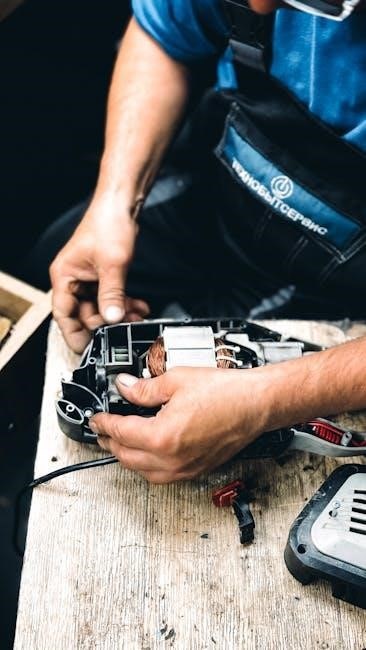
pitco fryer troubleshooting manual
This manual provides essential troubleshooting guidance for Pitco fryers, addressing common issues like power failures, temperature problems, and oil maintenance․ It offers step-by-step solutions to ensure optimal performance and minimize downtime, helping you maintain your fryer’s efficiency and longevity․
Importance of Regular Maintenance
Regular maintenance is crucial for ensuring your Pitco fryer operates efficiently and safely․ Daily cleaning prevents grease buildup, while weekly inspections of components like the thermostat, heating elements, and oil tank help identify potential issues early․ Proper oil care, including filtering and timely replacement, maintains food quality and extends the fryer’s lifespan․ Neglecting maintenance can lead to breakdowns, safety hazards, and increased operational costs․ By following a consistent maintenance routine, you can prevent unexpected downtime, ensure consistent frying results, and prolong the overall lifespan of your Pitco fryer․ A well-maintained fryer not only performs better but also contributes to a safer and more productive kitchen environment․
Common Issues and Solutions Overview
Pitco fryers, like any kitchen equipment, can encounter issues such as failure to power on, temperature malfunctions, or oil quality degradation․ Power issues often stem from faulty cords or tripped breakers, while temperature problems may involve mis-calibrated thermostats or faulty heating elements․ Oil-related issues, such as poor food taste, can result from infrequent filtering or improper storage․ Addressing these problems promptly is key to maintaining efficiency․ Solutions range from simple checks of power connections to more involved tasks like replacing components or resetting systems; This manual provides a comprehensive overview of these common issues and their fixes, ensuring you can resolve problems quickly and effectively, keeping your fryer in optimal condition and your kitchen running smoothly․
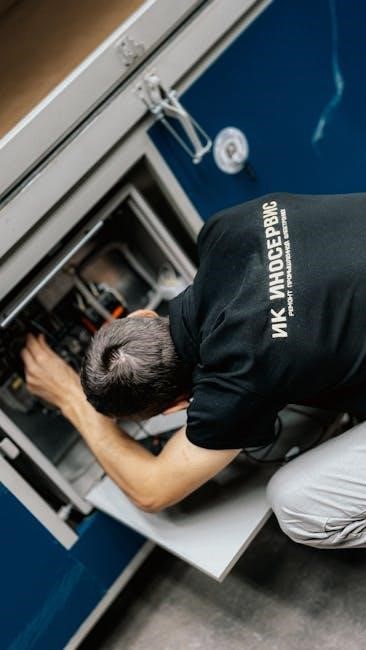
Pitco Fryer Not Turning On
If your Pitco fryer won’t turn on, start by checking the power supply․ Ensure the fryer is properly plugged in and the outlet is functioning․ Inspect the power cord for damage and check the circuit breaker․ If these steps don’t resolve the issue, contact a professional technician for further assistance․
Checking the Power Supply
Start by verifying the power supply to your Pitco fryer․ Ensure the fryer is properly plugged into a functioning outlet․ Check that the power cord is securely connected to both the fryer and the electrical outlet․ If the outlet is questionable, test it with another appliance to confirm it’s working․ Additionally, ensure the power switch on the fryer is in the “ON” position․ If the fryer still doesn’t power on, inspect the circuit breaker or fuse box to ensure the circuit hasn’t tripped or blown․ If all these steps fail, the issue may lie within the fryer’s internal electrical components, requiring professional assistance․
Inspecting the Power Cord

Examine the power cord for any visible damage, such as cuts, frays, or exposed wires․ A damaged cord can prevent the fryer from receiving power and poses a safety risk․ If you find any damage, do not use the fryer until the cord is replaced․ Gently flex the cord to check for internal breaks․ Ensure the cord is securely plugged into both the fryer and the outlet․ If the cord appears damaged or worn, contact a professional to install a replacement․ Regular inspections of the power cord can help prevent unexpected issues and ensure safe, reliable operation of your Pitco fryer․
Resetting the Circuit Breaker
Resetting the circuit breaker is a simple yet effective step to restore power to your Pitco fryer․ Locate the main electrical panel in your kitchen․ Identify the breaker controlling the fryer circuit․ Flip the breaker to the “OFF” position and wait a few seconds before switching it back to “ON․” This action resets the circuit and may resolve power issues caused by an overload or temporary malfunction․ If the breaker trips again after resetting, it could indicate an underlying electrical problem, such as a short circuit or overloaded circuit․ In such cases, consult a licensed electrician to diagnose and repair the issue․ Regularly checking and maintaining your circuit breaker ensures reliable operation of your fryer․
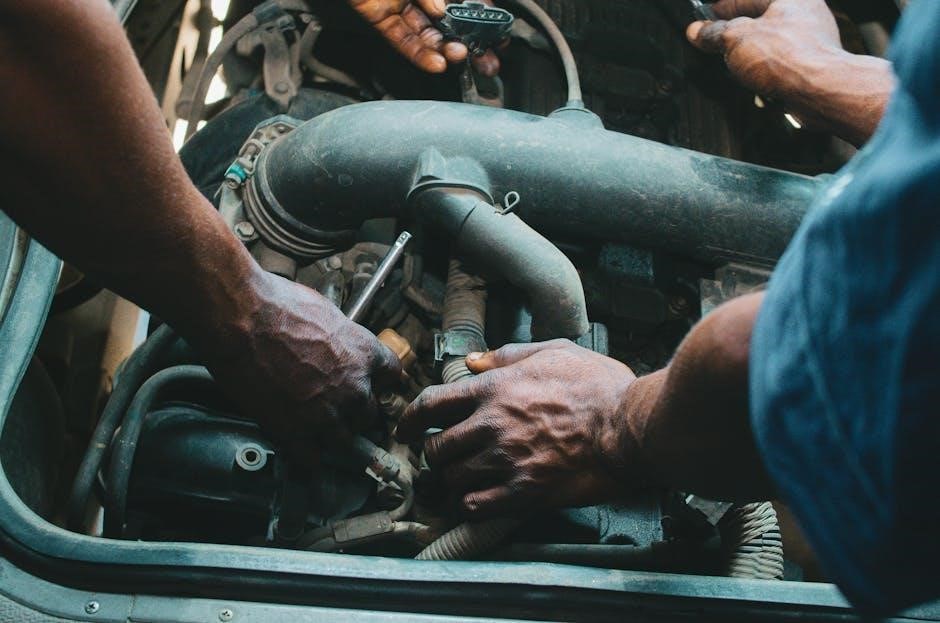
Temperature-Related Problems
Addressing temperature issues is crucial for optimal frying performance․ Incorrect settings or faulty components can lead to uneven cooking or safety hazards, requiring prompt troubleshooting and adjustment․
Thermostat Calibration Steps
Calibrating your Pitco fryer’s thermostat ensures accurate temperature control, crucial for consistent frying results․ Start by preheating the fryer to the desired temperature․ Allow it to stabilize for 10-15 minutes․ Use a food thermometer to verify the oil temperature․ If the reading differs from the thermostat, adjust the thermostat by turning the calibration knob․ Repeat the process until the displayed temperature matches the actual reading․ Regular calibration prevents overheating or underheating, ensuring food safety and quality․ Always refer to your manual for specific calibration instructions, as procedures may vary slightly between models․ Proper calibration extends the fryer’s lifespan and maintains optimal performance․
Identifying a Faulty Heating Element
A faulty heating element can prevent your Pitco fryer from reaching the desired temperature․ Look for signs such as inconsistent heating, reduced frying efficiency, or visible damage to the element․ Check if the element is loose or corroded, as this can disrupt its function․ Use a multimeter to test for continuity; a lack of continuity indicates a broken element․ If the fryer’s temperature fluctuates or fails to maintain heat, the heating element may be failing․ Replace it promptly to avoid further issues․ Always ensure the fryer is cool and unplugged before performing any inspections or replacements to guarantee safety and prevent electrical hazards․
Understanding Thermopile Issues
The thermopile in your Pitco fryer plays a crucial role in converting heat into electrical energy, which powers the gas valve and maintains the pilot light․ Common issues include a faulty thermocouple, which can cause the pilot light to go out, or dirt and debris blocking the pilot flame․ If the thermopile is not functioning properly, the fryer may fail to ignite or maintain heat․ To diagnose, ensure the thermocouple tip is correctly positioned in the flame and free from obstructions; If issues persist, the thermopile may need replacement․ Regular cleaning and inspection can prevent many thermopile-related problems, ensuring consistent fryer performance and safety․
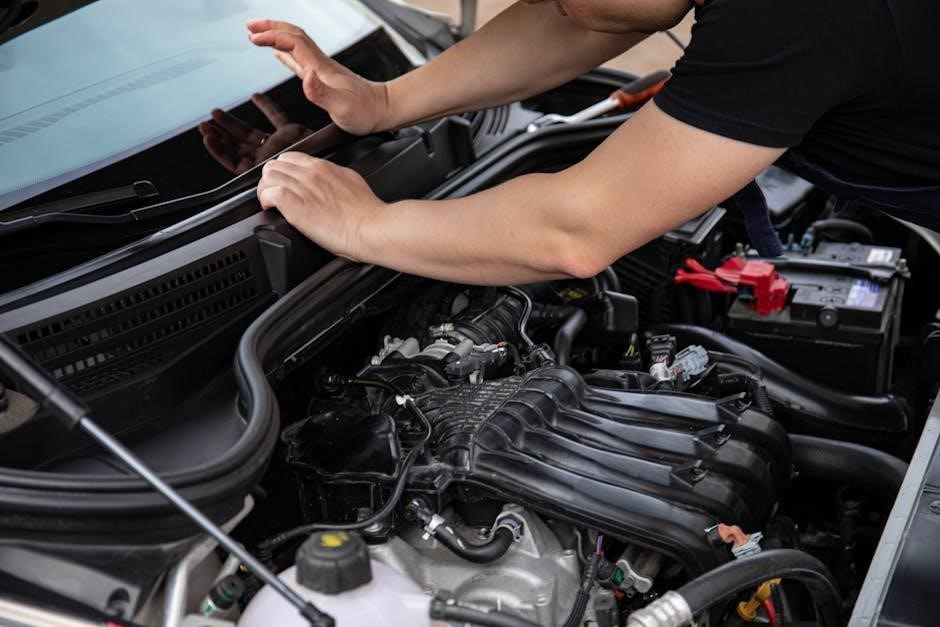
Oil Quality and Maintenance
Maintaining oil quality is crucial for both food taste and fryer performance․ Regular filtering and storage prevent degradation, ensuring optimal frying results and extending lifespan․
Regular Filtering and Cleaning
Regular filtering and cleaning are essential for maintaining oil quality and fryer performance․ Daily filtering removes food particles and contaminants, preventing oil degradation․ Use a filter paper or fine mesh to strain the oil, ensuring it remains clean and free from debris․ After filtering, clean the fryer tank with warm water and mild detergent to remove residue․ Avoid using abrasive materials that could damage the tank․ Proper cleaning prevents the buildup of harmful substances that can affect food taste and fryer efficiency․ Regular maintenance also extends the lifespan of your oil, reducing the need for frequent replacements and keeping your fryer in optimal condition․
Scheduling Oil Replacement
Scheduling regular oil replacement is crucial for maintaining your Pitco fryer’s performance and food quality․ Over time, frying oil degrades, absorbing moisture and food particles, which can affect taste and fryer efficiency․ Replace the oil every 1-3 months, depending on usage and filtration habits․ Signs of needing replacement include a rancid odor, dark color, or excessive smoking․ Always use high-quality oil designed for frying to ensure optimal results․ Proper oil replacement prevents contamination and extends the fryer’s lifespan․ Schedule replacements during low-activity periods to minimize downtime․ Consistent oil maintenance ensures your fryer operates efficiently and delivers consistent, high-quality fried foods․
Proper Oil Storage Techniques
Proper oil storage is essential to maintain the quality and usability of your frying oil․ Store oil in a cool, dark place to prevent degradation from heat and light․ Use airtight containers to protect the oil from air exposure, which can cause oxidation and rancidity․ Ensure the storage area is clean and free from contaminants to avoid spoilage․ Label the containers with the date to ensure older oil is used first․ Avoid storing oil near strong-smelling foods, as it can absorb odors․ Proper storage techniques help maintain oil quality, extend its shelf life, and ensure consistent frying results․ Regularly inspect stored oil for signs of spoilage before use․

Pilot Light Issues
Pilot light problems can disrupt frying operations․ Address issues by checking the thermocouple, cleaning the pilot burner, and ensuring a stable gas supply for consistent performance․
Troubleshooting the Thermocouple
The thermocouple is a critical component that senses the pilot flame and controls the gas valve․ If the pilot light won’t stay lit, the thermocouple may be faulty․
First, inspect the thermocouple for visible damage or misalignment․ Ensure it is properly positioned in the pilot flame․
If the thermocouple is damaged, replace it immediately․ A faulty thermocouple will prevent the gas valve from staying open, causing the pilot light to extinguish․
To test the thermocouple, use a multimeter to check for continuity․ If there is no continuity, the thermocouple needs replacement․
Always follow safety guidelines when working with gas components, and consult a professional if unsure․ A functioning thermocouple is essential for safe and efficient fryer operation․
Cleaning the Pilot Burner
Cleaning the pilot burner is essential for maintaining a steady flame and ensuring proper gas flow․ Over time, debris and food residue can accumulate, blocking the gas ports;
To clean the pilot burner, turn off the fryer and allow it to cool completely․ Use a soft-bristle brush or compressed air to gently remove dirt and buildup․
Inspect the gas port for obstructions and ensure it is clear․ A clean pilot burner ensures a consistent flame, preventing issues with the pilot light staying lit․
Regular cleaning helps prevent burner malfunctions and maintains efficient frying performance․ Always follow safety guidelines when handling gas components and internal parts of your Pitco fryer․
Ensuring Gas Supply Stability
A stable gas supply is crucial for the proper operation of your Pitco fryer․ Start by verifying that the gas valve is fully open and functioning correctly․
Inspect the gas line for kinks, blockages, or leaks, which can disrupt the flow․ If you suspect a leak, apply a soapy solution to the line; bubbles will indicate a leak․
Ensure the gas supply line is securely connected to both the fryer and the gas source․ Proper ventilation in the kitchen is also essential to prevent gas buildup․
If issues persist, consult a professional to check for internal gas system problems․ Regular inspections and maintenance can help prevent gas supply instability, ensuring safe and efficient frying operations․
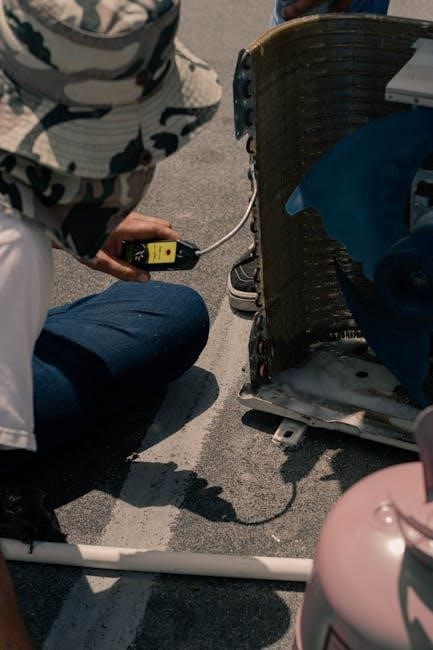
Burner Malfunction Solutions
Address burner issues by diagnosing ignition problems, adjusting flame settings for efficiency, and performing regular cleaning of the burner assembly to ensure optimal performance and safety․
Diagnosing Ignition Problems
If your Pitco fryer’s burner fails to ignite, start by checking the power supply․ Ensure the fryer is properly plugged in and the power switch is turned on․ Next, inspect the pilot light․ If the pilot light is out, attempt to relight it according to the manufacturer’s instructions․ If the pilot light refuses to stay lit, the thermocouple may be faulty․ A malfunctioning thermocouple prevents the gas valve from staying open, halting ignition․ Additionally, verify that the gas valve is fully open and not obstructed․ If these steps don’t resolve the issue, consult the manual or contact a professional technician․ Promptly addressing ignition problems is crucial to avoid disruptions in your kitchen operations․
Adjusting Flame for Efficiency
Proper flame adjustment is crucial for efficient frying․ A well-adjusted flame ensures even heat distribution and prevents energy waste․ To achieve the ideal flame, observe its color and size․ The flame should be blue with a yellow tip, indicating optimal combustion․ If the flame appears too yellow, adjust the air shutter to increase airflow․ Open the shutter slightly to allow more air intake, which should turn the flame blue․ If the flame is too high or low, adjust the gas pressure according to the manufacturer’s guidelines․ Proper flame adjustment not only enhances frying performance but also reduces energy consumption and ensures consistent food quality․ Regularly check and adjust the flame to maintain peak efficiency․
Cleaning and Maintaining Burners
Regular cleaning and maintenance of your Pitco fryer’s burners are essential for optimal performance․ Start by turning off the fryer and allowing it to cool completely․ Remove the burner assembly and use a soft-bristle brush to clean out any debris or food particles from the burner holes․ This ensures proper gas flow and prevents uneven heating․ Wipe the burner surfaces with a damp cloth to remove grease and grime․ Inspect for signs of corrosion or damage and replace any worn-out parts․ Reassemble the burner and ensure all connections are secure․ Regular maintenance prevents clogs, improves efficiency, and extends the lifespan of your fryer․ Clean burners also reduce the risk of safety hazards and ensure consistent frying results․

Control Panel Malfunctions
Address display issues, unresponsive buttons, and control board problems․ Check power connections, clean buttons, and reset the board if necessary to restore functionality and ensure smooth operation․
Resolving Display Issues
If your Pitco fryer’s display is malfunctioning, start by ensuring the unit is properly plugged in and the power switch is on․ Check for loose connections or damaged wires, as these can disrupt the display․ If the issue persists, inspect the control panel for any visible damage or debris․ Clean the display gently with a soft cloth to remove any grime or splatters that might be obscuring the screen․ If the display is cracked or unresponsive, it may need replacement․ Refer to your manual for specific instructions on replacing the display or contact a professional technician for assistance․ Regular maintenance and inspections can help prevent such issues from arising․
Fixing Unresponsive Buttons
If the buttons on your Pitco fryer’s control panel are unresponsive, begin by cleaning them thoroughly․ Use a soft cloth and a mild cleaner to remove grease or debris that may be blocking the buttons․ Ensure the cloth is damp, not soaking wet, to avoid moisture damage․ If cleaning doesn’t resolve the issue, inspect the buttons for visible damage or wear․ Damaged buttons may need to be replaced․ Refer to your Pitco fryer manual for guidance on replacing buttons or contact a professional technician․ Regular cleaning and maintenance can help prevent button malfunctions and ensure smooth operation of your fryer․
Resetting the Control Board
Resetting the control board on your Pitco fryer can often resolve malfunctions․ To do this, turn off the fryer and unplug it from the power source․ Wait for 5-10 minutes to allow any residual power to discharge․ Plug the fryer back in and turn it on․ This simple reset can resolve issues like display malfunctions or unresponsive buttons․ If the problem persists, the control board may need professional attention․ Regular resets can help maintain the fryer’s performance and prevent unexpected shutdowns․ Always follow safety guidelines when performing resets to avoid electrical hazards․ This step is a quick and effective troubleshooting solution for many control-related issues․
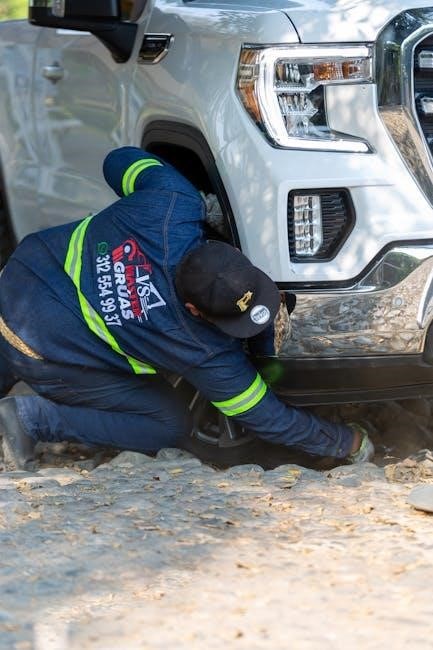
Preventive Maintenance Tips
Preventive maintenance is crucial for extending your Pitco fryer’s lifespan and ensuring efficient operation․ Regular cleaning, component inspections, and professional servicing help prevent breakdowns and maintain performance․
Daily Cleaning Routine
A daily cleaning routine is essential for maintaining your Pitco fryer’s performance and longevity․ Start by wiping down the exterior with a soft cloth to remove grease and splatters․ Clean the fryer pot thoroughly after each use, removing food particles and residue․ Use a soft brush to scrub the interior, ensuring no debris remains․ Drain and filter the oil daily to prevent contamination․ For tougher stains, mix warm water with a mild detergent and apply it to the affected areas․ Avoid using abrasive cleaners or scouring pads, as they can damage the fryer’s surfaces․ Regular cleaning prevents grease buildup, ensures consistent frying results, and maintains hygiene standards․ Consistency in this routine will help extend the life of your fryer and keep it operating efficiently․
Regular Component Inspections
Regular inspections of your Pitco fryer’s components are crucial for preventing breakdowns and ensuring safe, efficient operation․ Start by checking the fryer pot for any signs of wear or damage․ Inspect the gas lines and connections for leaks or looseness, and ensure they are secure․ Examine the power cord for fraying or damage, and verify that all electrical connections are tight․ Check the thermostat for accuracy and the heating elements for proper function․ Look for any signs of corrosion or rust on metal parts․ Regularly inspecting these components helps identify potential issues early, preventing costly repairs and downtime․ Schedule professional servicing annually to inspect internal components and ensure everything is in optimal condition․ This proactive approach ensures your fryer operates safely and efficiently, minimizing the risk of unexpected failures․ Regular inspections are a key part of maintaining your Pitco fryer’s performance and longevity․
Scheduling Professional Servicing
Scheduling professional servicing for your Pitco fryer is essential for maintaining its performance and longevity․ A qualified technician will inspect all components, including the heating elements, thermostat, and gas lines, to ensure they are functioning correctly; During the service, internal parts will be cleaned, and any worn-out components will be replaced․ This helps prevent unexpected breakdowns and ensures the fryer operates safely and efficiently․ Professional servicing also allows for early detection of potential issues, saving you time and money in the long run․ It is recommended to schedule this service at least once a year, depending on usage․ Regular professional maintenance ensures your Pitco fryer continues to deliver optimal results and extends its lifespan․
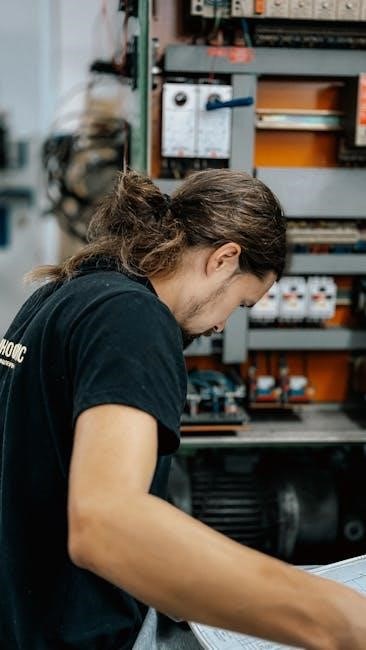
Resetting Your Pitco Fryer
To reset your Pitco fryer, locate the reset button near the control panel․ Press and hold it for a few seconds to restore default settings․ Ensure the fryer is turned off before resetting to avoid electrical issues․ After resetting, plug it back in and test its operation․ If issues persist, check for loose connections or faulty components and address them accordingly․
Locating the Reset Button
The reset button on your Pitco fryer is typically located near the control panel or on the back of the unit․ To find it, first, ensure the fryer is turned off for safety․ Check the control panel area, as the reset button is often recessed or marked clearly․ If it’s not visible, refer to your Pitco fryer manual for specific location details․ Some models may have the reset button behind a protective cover or near the power cord․ Once located, press and hold the button for a few seconds to reset the fryer․ If you cannot find it, consult the manual or contact a professional for assistance․ Proper resetting helps resolve many operational issues effectively․
Post-Reset Troubleshooting
After resetting your Pitco fryer, ensure all components are functioning properly․ Check for loose connections or damaged seals, as these can cause oil leaks or performance issues․ Test the fryer by turning it on and monitoring its operation․ If it doesn’t heat up, inspect the thermostat or heating element for faults․ Verify that the oil level is adequate and the temperature settings are correct․ If the fryer shuts off unexpectedly, check for overheating issues or a faulty safety switch․ Clean the fryer thoroughly, especially the burners and vents, to ensure proper airflow and ignition․ Regular maintenance, such as filtering oil and inspecting gas lines, can prevent recurring problems․ Addressing these steps post-reset helps restore your fryer to optimal performance․
This manual provides comprehensive troubleshooting solutions for Pitco fryers, ensuring optimal performance and longevity․ Regular maintenance and prompt issue resolution will enhance your frying experience and food quality․
Addressing Pitco fryer issues starts with checking the power supply and inspecting cords for damage․ Resetting the circuit breaker or calibrating the thermostat can resolve many problems․ For temperature-related issues, ensure the heating element and thermopile are functioning properly․ Regularly filter and replace oil to maintain quality and performance․ Pilot light problems often require cleaning the burner or replacing the thermocouple․ Burner malfunctions may involve adjusting the flame or cleaning debris․ Control panel issues can be fixed by resetting the board or replacing faulty components․ Daily cleaning and routine inspections are crucial for preventing breakdowns․ Always consult the manual for specific guidance, and seek professional help if issues persist․ Proper maintenance ensures optimal performance and longevity․
Final Tips for Optimal Fryer Performance
Regular maintenance is key to ensuring your Pitco fryer operates at its best․ Daily cleaning of the exterior and fryer pot prevents grease buildup, while weekly oil changes maintain quality․ Store oil in a cool, dark place to prevent degradation․ Schedule annual professional servicing to address internal components and replace worn parts․ Monitor temperature settings to avoid overheating, which can damage oil and affect food taste․ Always ensure secure connections and follow the manual’s guidelines for troubleshooting․ By adhering to these practices, you can extend the fryer’s lifespan, maintain efficiency, and ensure consistent, high-quality frying results․ Proper care translates to better performance and safety․